Boutique Build: Leadership Development Framework Report and Plan
VerifiedAdded on 2023/01/18
|10
|2080
|20
Report
AI Summary
This report details a leadership development framework designed for Boutique Build, a residential construction company. The framework focuses on developing emerging leaders capable of driving positive change within the organization. It addresses key areas such as change management, emphasizing strategies to manage resistance and foster acceptance of new initiatives through rewards and recognition. Communication strategies are highlighted, advocating for transparent and active listening to improve employee engagement and understanding. Team development is also a central focus, with the goal of identifying roles, promoting collaboration, and aligning individual goals with company objectives. Finally, the framework emphasizes the importance of problem-solving, encouraging leaders to devise creative solutions for both employee and customer challenges, ultimately aiming to improve operational efficiency and enhance customer satisfaction. The report includes a leadership development plan outlining skills, target areas, timeframes, and success criteria for the framework's implementation.
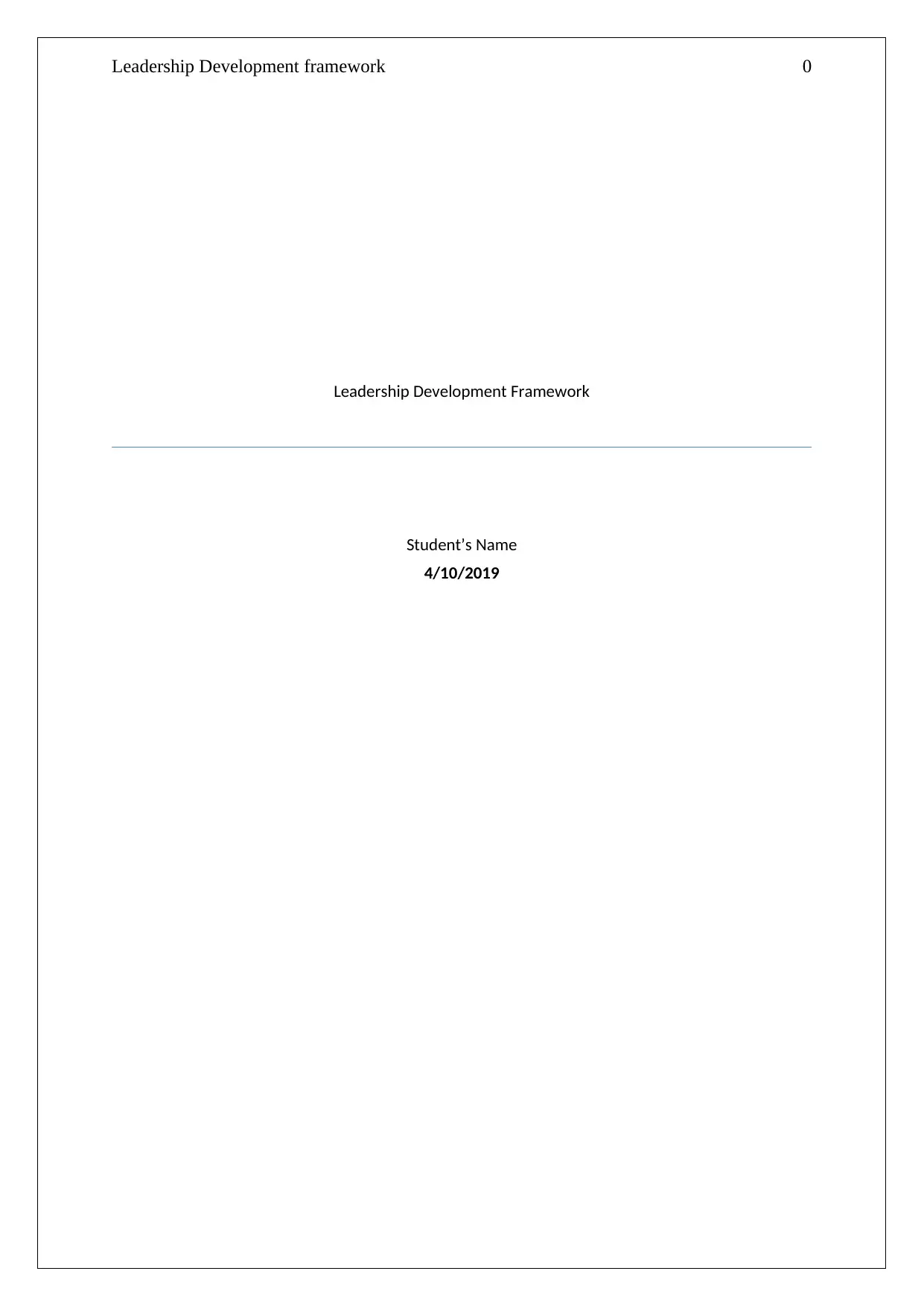
Leadership Development framework 0
Leadership Development Framework
Student’s Name
4/10/2019
Leadership Development Framework
Student’s Name
4/10/2019
Paraphrase This Document
Need a fresh take? Get an instant paraphrase of this document with our AI Paraphraser
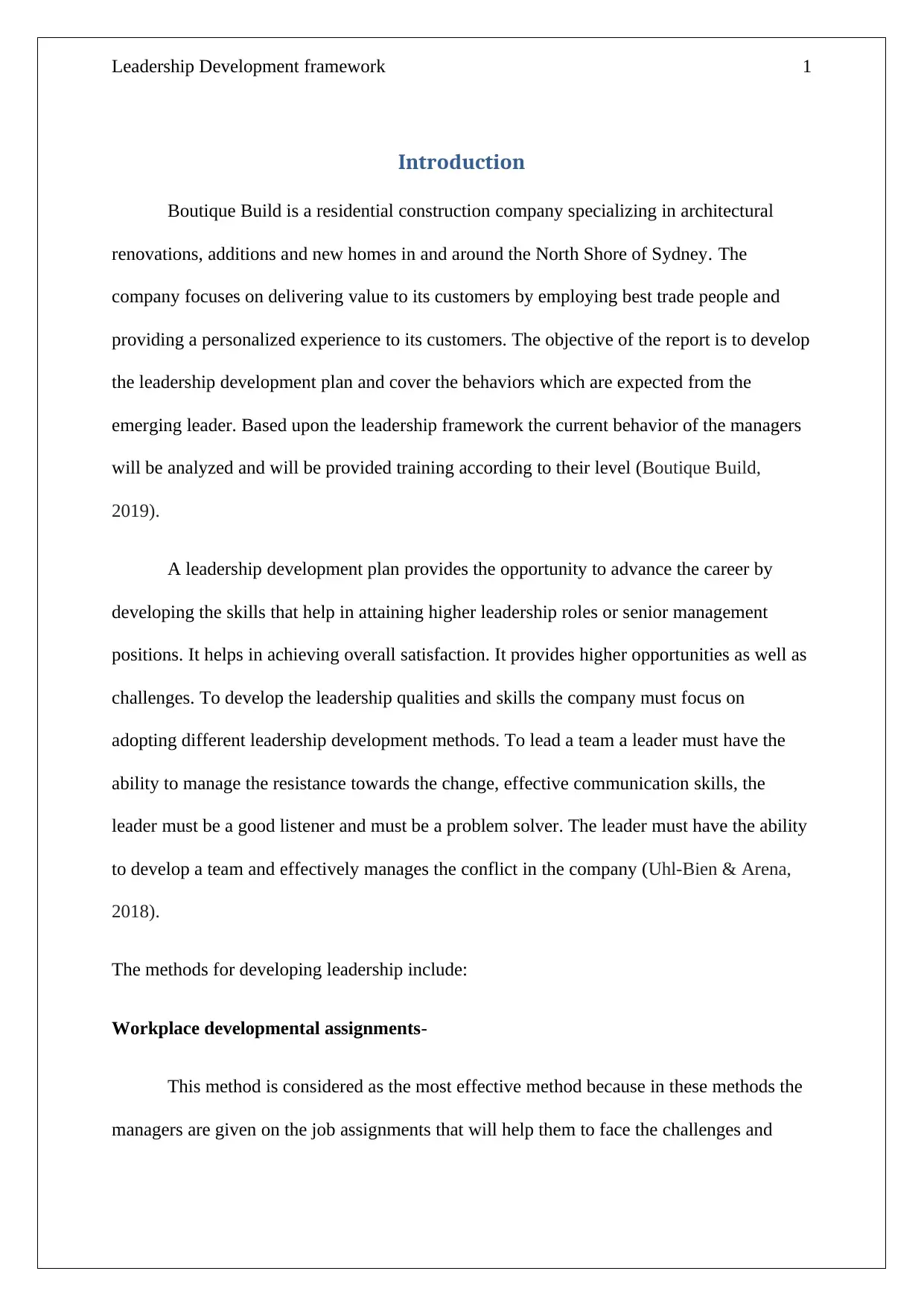
Leadership Development framework 1
Introduction
Boutique Build is a residential construction company specializing in architectural
renovations, additions and new homes in and around the North Shore of Sydney. The
company focuses on delivering value to its customers by employing best trade people and
providing a personalized experience to its customers. The objective of the report is to develop
the leadership development plan and cover the behaviors which are expected from the
emerging leader. Based upon the leadership framework the current behavior of the managers
will be analyzed and will be provided training according to their level (Boutique Build,
2019).
A leadership development plan provides the opportunity to advance the career by
developing the skills that help in attaining higher leadership roles or senior management
positions. It helps in achieving overall satisfaction. It provides higher opportunities as well as
challenges. To develop the leadership qualities and skills the company must focus on
adopting different leadership development methods. To lead a team a leader must have the
ability to manage the resistance towards the change, effective communication skills, the
leader must be a good listener and must be a problem solver. The leader must have the ability
to develop a team and effectively manages the conflict in the company (Uhl-Bien & Arena,
2018).
The methods for developing leadership include:
Workplace developmental assignments-
This method is considered as the most effective method because in these methods the
managers are given on the job assignments that will help them to face the challenges and
Introduction
Boutique Build is a residential construction company specializing in architectural
renovations, additions and new homes in and around the North Shore of Sydney. The
company focuses on delivering value to its customers by employing best trade people and
providing a personalized experience to its customers. The objective of the report is to develop
the leadership development plan and cover the behaviors which are expected from the
emerging leader. Based upon the leadership framework the current behavior of the managers
will be analyzed and will be provided training according to their level (Boutique Build,
2019).
A leadership development plan provides the opportunity to advance the career by
developing the skills that help in attaining higher leadership roles or senior management
positions. It helps in achieving overall satisfaction. It provides higher opportunities as well as
challenges. To develop the leadership qualities and skills the company must focus on
adopting different leadership development methods. To lead a team a leader must have the
ability to manage the resistance towards the change, effective communication skills, the
leader must be a good listener and must be a problem solver. The leader must have the ability
to develop a team and effectively manages the conflict in the company (Uhl-Bien & Arena,
2018).
The methods for developing leadership include:
Workplace developmental assignments-
This method is considered as the most effective method because in these methods the
managers are given on the job assignments that will help them to face the challenges and
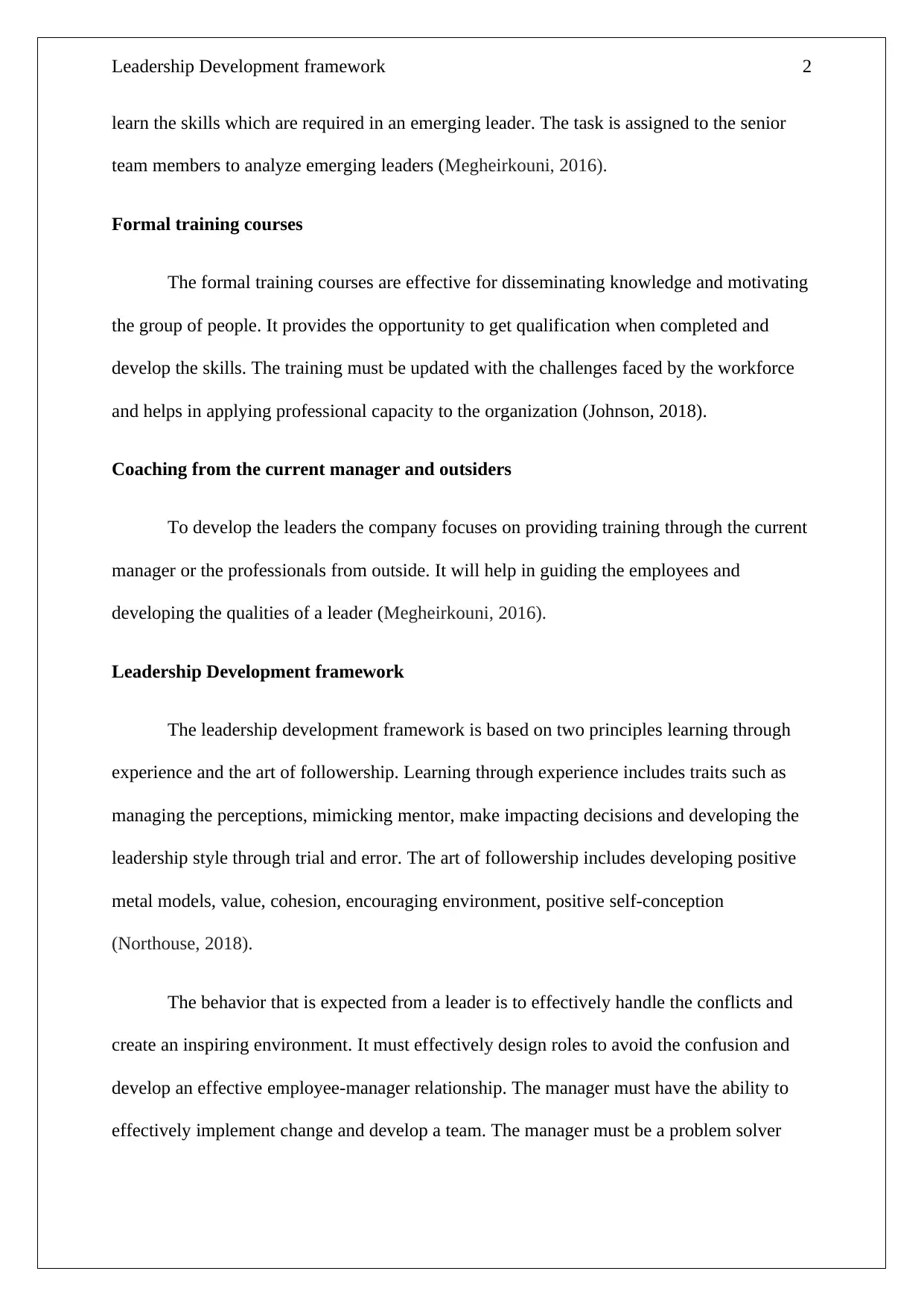
Leadership Development framework 2
learn the skills which are required in an emerging leader. The task is assigned to the senior
team members to analyze emerging leaders (Megheirkouni, 2016).
Formal training courses
The formal training courses are effective for disseminating knowledge and motivating
the group of people. It provides the opportunity to get qualification when completed and
develop the skills. The training must be updated with the challenges faced by the workforce
and helps in applying professional capacity to the organization (Johnson, 2018).
Coaching from the current manager and outsiders
To develop the leaders the company focuses on providing training through the current
manager or the professionals from outside. It will help in guiding the employees and
developing the qualities of a leader (Megheirkouni, 2016).
Leadership Development framework
The leadership development framework is based on two principles learning through
experience and the art of followership. Learning through experience includes traits such as
managing the perceptions, mimicking mentor, make impacting decisions and developing the
leadership style through trial and error. The art of followership includes developing positive
metal models, value, cohesion, encouraging environment, positive self-conception
(Northouse, 2018).
The behavior that is expected from a leader is to effectively handle the conflicts and
create an inspiring environment. It must effectively design roles to avoid the confusion and
develop an effective employee-manager relationship. The manager must have the ability to
effectively implement change and develop a team. The manager must be a problem solver
learn the skills which are required in an emerging leader. The task is assigned to the senior
team members to analyze emerging leaders (Megheirkouni, 2016).
Formal training courses
The formal training courses are effective for disseminating knowledge and motivating
the group of people. It provides the opportunity to get qualification when completed and
develop the skills. The training must be updated with the challenges faced by the workforce
and helps in applying professional capacity to the organization (Johnson, 2018).
Coaching from the current manager and outsiders
To develop the leaders the company focuses on providing training through the current
manager or the professionals from outside. It will help in guiding the employees and
developing the qualities of a leader (Megheirkouni, 2016).
Leadership Development framework
The leadership development framework is based on two principles learning through
experience and the art of followership. Learning through experience includes traits such as
managing the perceptions, mimicking mentor, make impacting decisions and developing the
leadership style through trial and error. The art of followership includes developing positive
metal models, value, cohesion, encouraging environment, positive self-conception
(Northouse, 2018).
The behavior that is expected from a leader is to effectively handle the conflicts and
create an inspiring environment. It must effectively design roles to avoid the confusion and
develop an effective employee-manager relationship. The manager must have the ability to
effectively implement change and develop a team. The manager must be a problem solver
⊘ This is a preview!⊘
Do you want full access?
Subscribe today to unlock all pages.

Trusted by 1+ million students worldwide
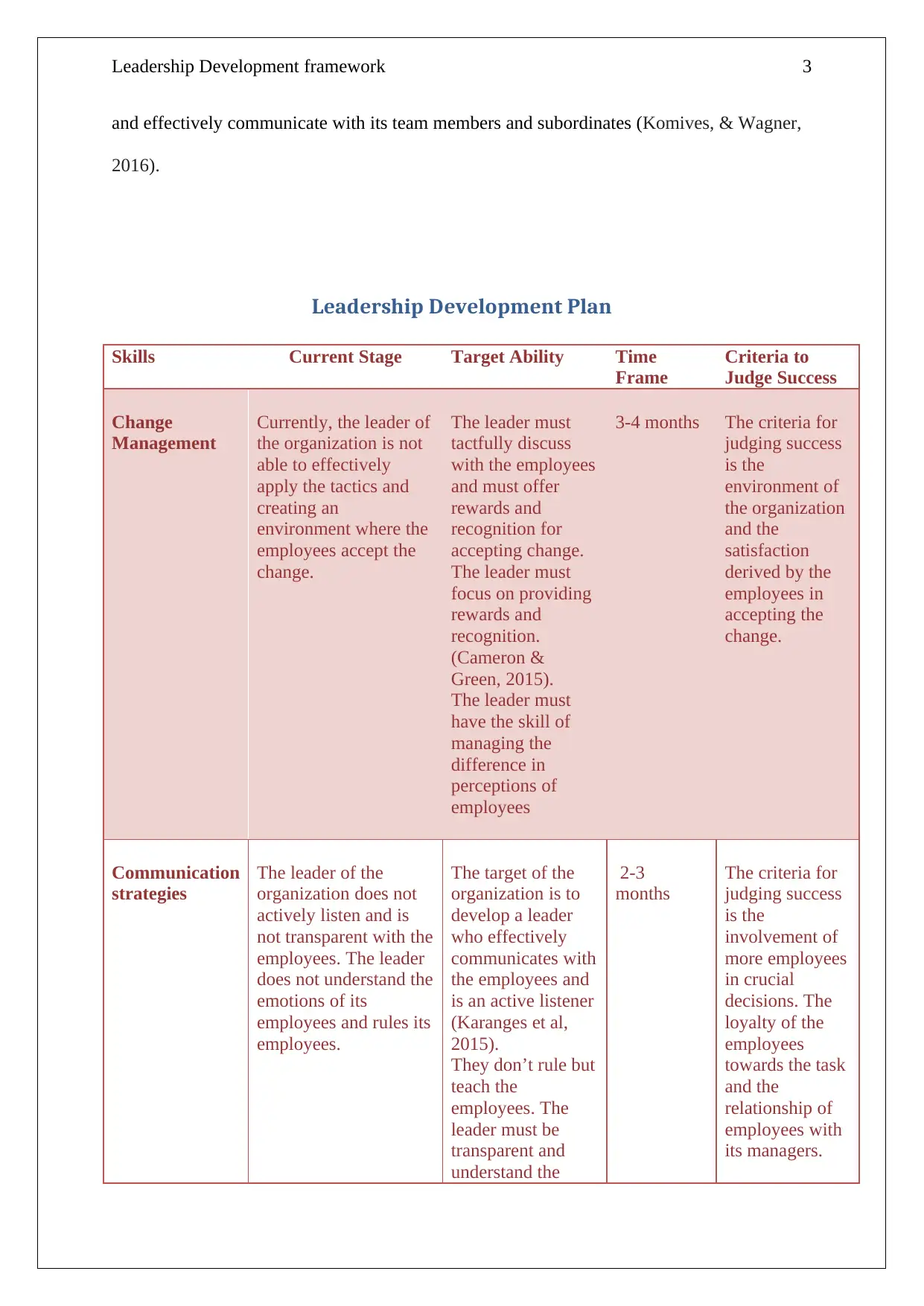
Leadership Development framework 3
and effectively communicate with its team members and subordinates (Komives, & Wagner,
2016).
Leadership Development Plan
Skills Current Stage Target Ability Time
Frame
Criteria to
Judge Success
Change
Management
Currently, the leader of
the organization is not
able to effectively
apply the tactics and
creating an
environment where the
employees accept the
change.
The leader must
tactfully discuss
with the employees
and must offer
rewards and
recognition for
accepting change.
The leader must
focus on providing
rewards and
recognition.
(Cameron &
Green, 2015).
The leader must
have the skill of
managing the
difference in
perceptions of
employees
3-4 months The criteria for
judging success
is the
environment of
the organization
and the
satisfaction
derived by the
employees in
accepting the
change.
Communication
strategies
The leader of the
organization does not
actively listen and is
not transparent with the
employees. The leader
does not understand the
emotions of its
employees and rules its
employees.
The target of the
organization is to
develop a leader
who effectively
communicates with
the employees and
is an active listener
(Karanges et al,
2015).
They don’t rule but
teach the
employees. The
leader must be
transparent and
understand the
2-3
months
The criteria for
judging success
is the
involvement of
more employees
in crucial
decisions. The
loyalty of the
employees
towards the task
and the
relationship of
employees with
its managers.
and effectively communicate with its team members and subordinates (Komives, & Wagner,
2016).
Leadership Development Plan
Skills Current Stage Target Ability Time
Frame
Criteria to
Judge Success
Change
Management
Currently, the leader of
the organization is not
able to effectively
apply the tactics and
creating an
environment where the
employees accept the
change.
The leader must
tactfully discuss
with the employees
and must offer
rewards and
recognition for
accepting change.
The leader must
focus on providing
rewards and
recognition.
(Cameron &
Green, 2015).
The leader must
have the skill of
managing the
difference in
perceptions of
employees
3-4 months The criteria for
judging success
is the
environment of
the organization
and the
satisfaction
derived by the
employees in
accepting the
change.
Communication
strategies
The leader of the
organization does not
actively listen and is
not transparent with the
employees. The leader
does not understand the
emotions of its
employees and rules its
employees.
The target of the
organization is to
develop a leader
who effectively
communicates with
the employees and
is an active listener
(Karanges et al,
2015).
They don’t rule but
teach the
employees. The
leader must be
transparent and
understand the
2-3
months
The criteria for
judging success
is the
involvement of
more employees
in crucial
decisions. The
loyalty of the
employees
towards the task
and the
relationship of
employees with
its managers.
Paraphrase This Document
Need a fresh take? Get an instant paraphrase of this document with our AI Paraphraser
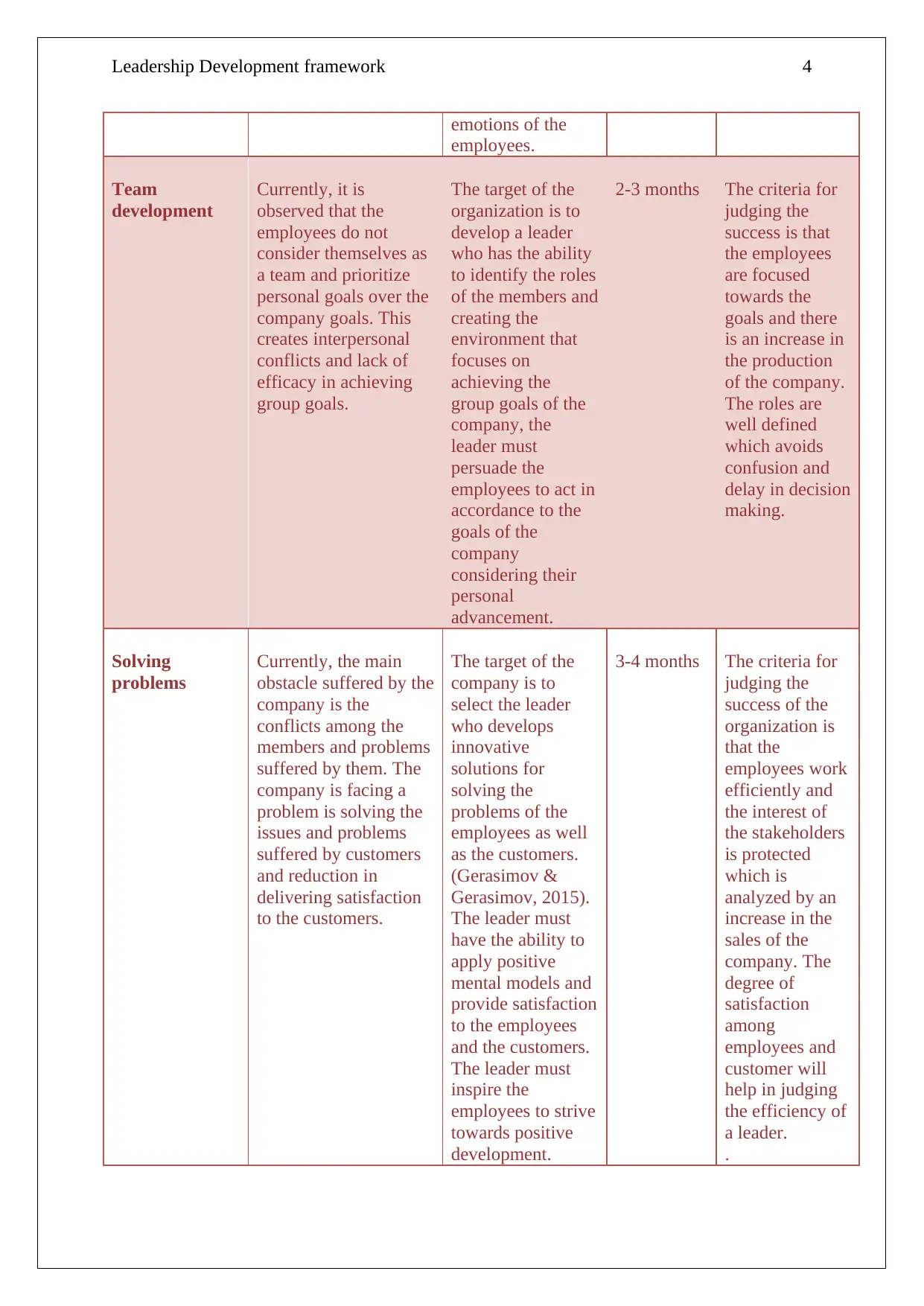
Leadership Development framework 4
emotions of the
employees.
Team
development
Currently, it is
observed that the
employees do not
consider themselves as
a team and prioritize
personal goals over the
company goals. This
creates interpersonal
conflicts and lack of
efficacy in achieving
group goals.
The target of the
organization is to
develop a leader
who has the ability
to identify the roles
of the members and
creating the
environment that
focuses on
achieving the
group goals of the
company, the
leader must
persuade the
employees to act in
accordance to the
goals of the
company
considering their
personal
advancement.
2-3 months The criteria for
judging the
success is that
the employees
are focused
towards the
goals and there
is an increase in
the production
of the company.
The roles are
well defined
which avoids
confusion and
delay in decision
making.
Solving
problems
Currently, the main
obstacle suffered by the
company is the
conflicts among the
members and problems
suffered by them. The
company is facing a
problem is solving the
issues and problems
suffered by customers
and reduction in
delivering satisfaction
to the customers.
The target of the
company is to
select the leader
who develops
innovative
solutions for
solving the
problems of the
employees as well
as the customers.
(Gerasimov &
Gerasimov, 2015).
The leader must
have the ability to
apply positive
mental models and
provide satisfaction
to the employees
and the customers.
The leader must
inspire the
employees to strive
towards positive
development.
3-4 months The criteria for
judging the
success of the
organization is
that the
employees work
efficiently and
the interest of
the stakeholders
is protected
which is
analyzed by an
increase in the
sales of the
company. The
degree of
satisfaction
among
employees and
customer will
help in judging
the efficiency of
a leader.
.
emotions of the
employees.
Team
development
Currently, it is
observed that the
employees do not
consider themselves as
a team and prioritize
personal goals over the
company goals. This
creates interpersonal
conflicts and lack of
efficacy in achieving
group goals.
The target of the
organization is to
develop a leader
who has the ability
to identify the roles
of the members and
creating the
environment that
focuses on
achieving the
group goals of the
company, the
leader must
persuade the
employees to act in
accordance to the
goals of the
company
considering their
personal
advancement.
2-3 months The criteria for
judging the
success is that
the employees
are focused
towards the
goals and there
is an increase in
the production
of the company.
The roles are
well defined
which avoids
confusion and
delay in decision
making.
Solving
problems
Currently, the main
obstacle suffered by the
company is the
conflicts among the
members and problems
suffered by them. The
company is facing a
problem is solving the
issues and problems
suffered by customers
and reduction in
delivering satisfaction
to the customers.
The target of the
company is to
select the leader
who develops
innovative
solutions for
solving the
problems of the
employees as well
as the customers.
(Gerasimov &
Gerasimov, 2015).
The leader must
have the ability to
apply positive
mental models and
provide satisfaction
to the employees
and the customers.
The leader must
inspire the
employees to strive
towards positive
development.
3-4 months The criteria for
judging the
success of the
organization is
that the
employees work
efficiently and
the interest of
the stakeholders
is protected
which is
analyzed by an
increase in the
sales of the
company. The
degree of
satisfaction
among
employees and
customer will
help in judging
the efficiency of
a leader.
.
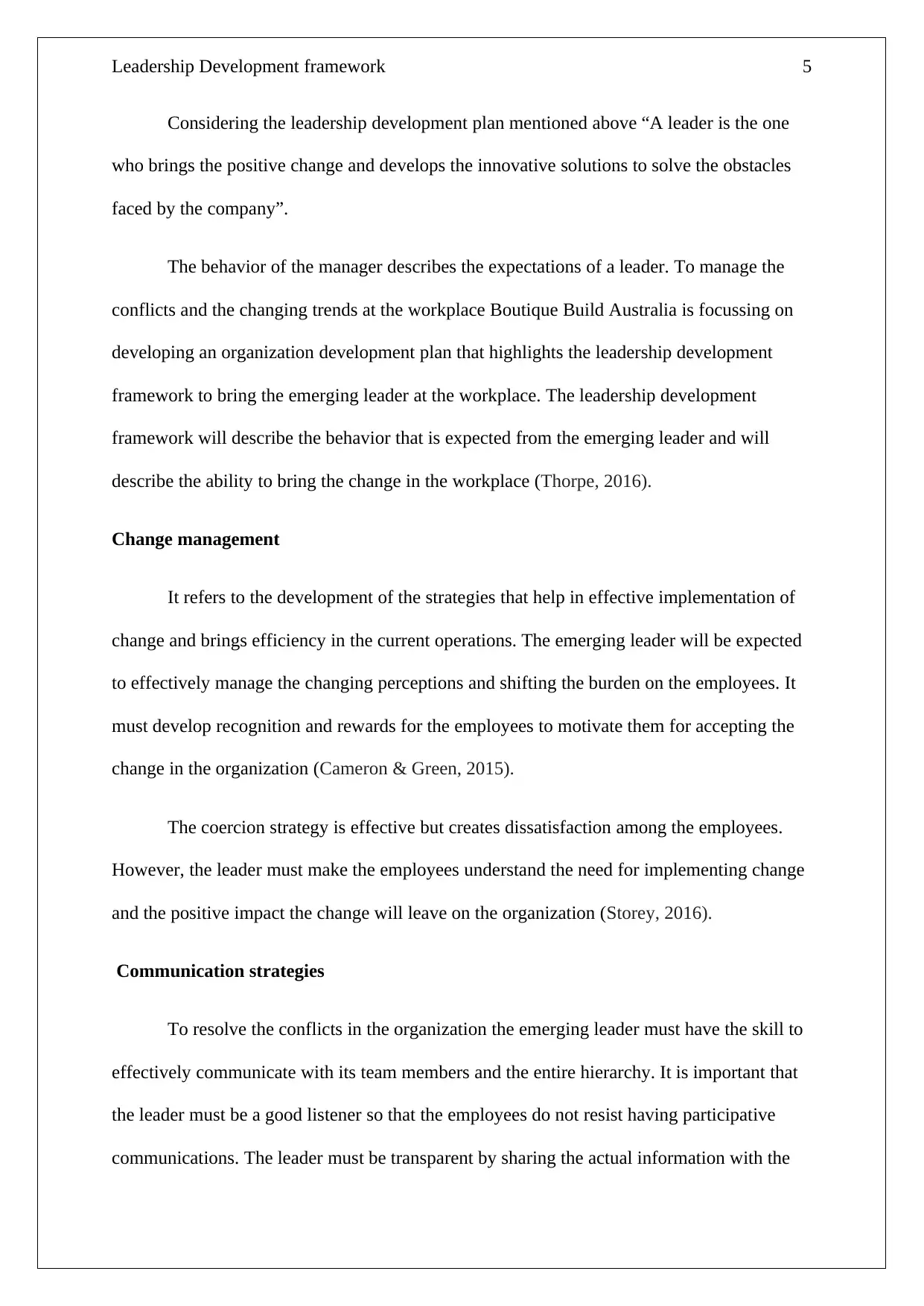
Leadership Development framework 5
Considering the leadership development plan mentioned above “A leader is the one
who brings the positive change and develops the innovative solutions to solve the obstacles
faced by the company”.
The behavior of the manager describes the expectations of a leader. To manage the
conflicts and the changing trends at the workplace Boutique Build Australia is focussing on
developing an organization development plan that highlights the leadership development
framework to bring the emerging leader at the workplace. The leadership development
framework will describe the behavior that is expected from the emerging leader and will
describe the ability to bring the change in the workplace (Thorpe, 2016).
Change management
It refers to the development of the strategies that help in effective implementation of
change and brings efficiency in the current operations. The emerging leader will be expected
to effectively manage the changing perceptions and shifting the burden on the employees. It
must develop recognition and rewards for the employees to motivate them for accepting the
change in the organization (Cameron & Green, 2015).
The coercion strategy is effective but creates dissatisfaction among the employees.
However, the leader must make the employees understand the need for implementing change
and the positive impact the change will leave on the organization (Storey, 2016).
Communication strategies
To resolve the conflicts in the organization the emerging leader must have the skill to
effectively communicate with its team members and the entire hierarchy. It is important that
the leader must be a good listener so that the employees do not resist having participative
communications. The leader must be transparent by sharing the actual information with the
Considering the leadership development plan mentioned above “A leader is the one
who brings the positive change and develops the innovative solutions to solve the obstacles
faced by the company”.
The behavior of the manager describes the expectations of a leader. To manage the
conflicts and the changing trends at the workplace Boutique Build Australia is focussing on
developing an organization development plan that highlights the leadership development
framework to bring the emerging leader at the workplace. The leadership development
framework will describe the behavior that is expected from the emerging leader and will
describe the ability to bring the change in the workplace (Thorpe, 2016).
Change management
It refers to the development of the strategies that help in effective implementation of
change and brings efficiency in the current operations. The emerging leader will be expected
to effectively manage the changing perceptions and shifting the burden on the employees. It
must develop recognition and rewards for the employees to motivate them for accepting the
change in the organization (Cameron & Green, 2015).
The coercion strategy is effective but creates dissatisfaction among the employees.
However, the leader must make the employees understand the need for implementing change
and the positive impact the change will leave on the organization (Storey, 2016).
Communication strategies
To resolve the conflicts in the organization the emerging leader must have the skill to
effectively communicate with its team members and the entire hierarchy. It is important that
the leader must be a good listener so that the employees do not resist having participative
communications. The leader must be transparent by sharing the actual information with the
⊘ This is a preview!⊘
Do you want full access?
Subscribe today to unlock all pages.

Trusted by 1+ million students worldwide
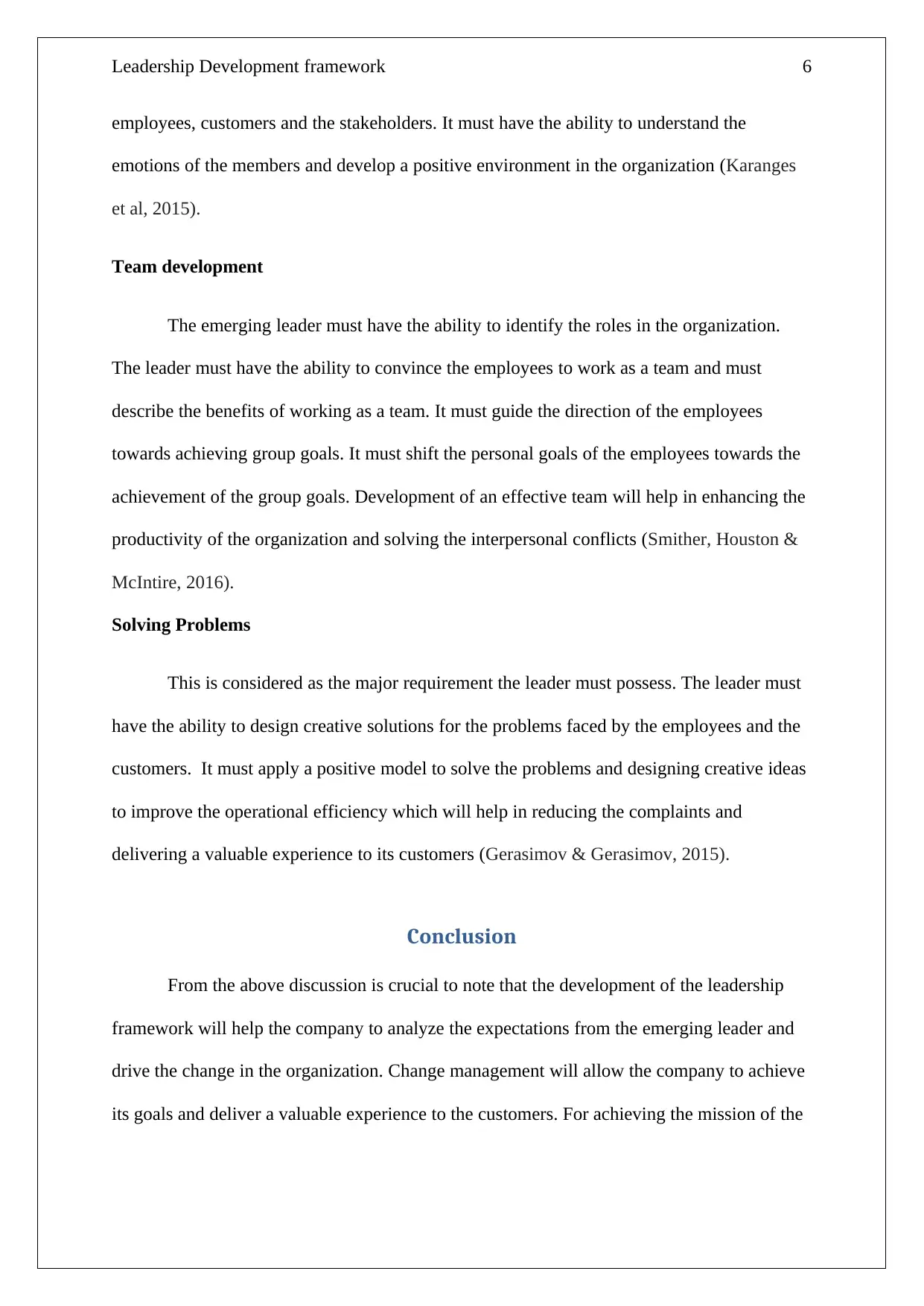
Leadership Development framework 6
employees, customers and the stakeholders. It must have the ability to understand the
emotions of the members and develop a positive environment in the organization (Karanges
et al, 2015).
Team development
The emerging leader must have the ability to identify the roles in the organization.
The leader must have the ability to convince the employees to work as a team and must
describe the benefits of working as a team. It must guide the direction of the employees
towards achieving group goals. It must shift the personal goals of the employees towards the
achievement of the group goals. Development of an effective team will help in enhancing the
productivity of the organization and solving the interpersonal conflicts (Smither, Houston &
McIntire, 2016).
Solving Problems
This is considered as the major requirement the leader must possess. The leader must
have the ability to design creative solutions for the problems faced by the employees and the
customers. It must apply a positive model to solve the problems and designing creative ideas
to improve the operational efficiency which will help in reducing the complaints and
delivering a valuable experience to its customers (Gerasimov & Gerasimov, 2015).
Conclusion
From the above discussion is crucial to note that the development of the leadership
framework will help the company to analyze the expectations from the emerging leader and
drive the change in the organization. Change management will allow the company to achieve
its goals and deliver a valuable experience to the customers. For achieving the mission of the
employees, customers and the stakeholders. It must have the ability to understand the
emotions of the members and develop a positive environment in the organization (Karanges
et al, 2015).
Team development
The emerging leader must have the ability to identify the roles in the organization.
The leader must have the ability to convince the employees to work as a team and must
describe the benefits of working as a team. It must guide the direction of the employees
towards achieving group goals. It must shift the personal goals of the employees towards the
achievement of the group goals. Development of an effective team will help in enhancing the
productivity of the organization and solving the interpersonal conflicts (Smither, Houston &
McIntire, 2016).
Solving Problems
This is considered as the major requirement the leader must possess. The leader must
have the ability to design creative solutions for the problems faced by the employees and the
customers. It must apply a positive model to solve the problems and designing creative ideas
to improve the operational efficiency which will help in reducing the complaints and
delivering a valuable experience to its customers (Gerasimov & Gerasimov, 2015).
Conclusion
From the above discussion is crucial to note that the development of the leadership
framework will help the company to analyze the expectations from the emerging leader and
drive the change in the organization. Change management will allow the company to achieve
its goals and deliver a valuable experience to the customers. For achieving the mission of the
Paraphrase This Document
Need a fresh take? Get an instant paraphrase of this document with our AI Paraphraser
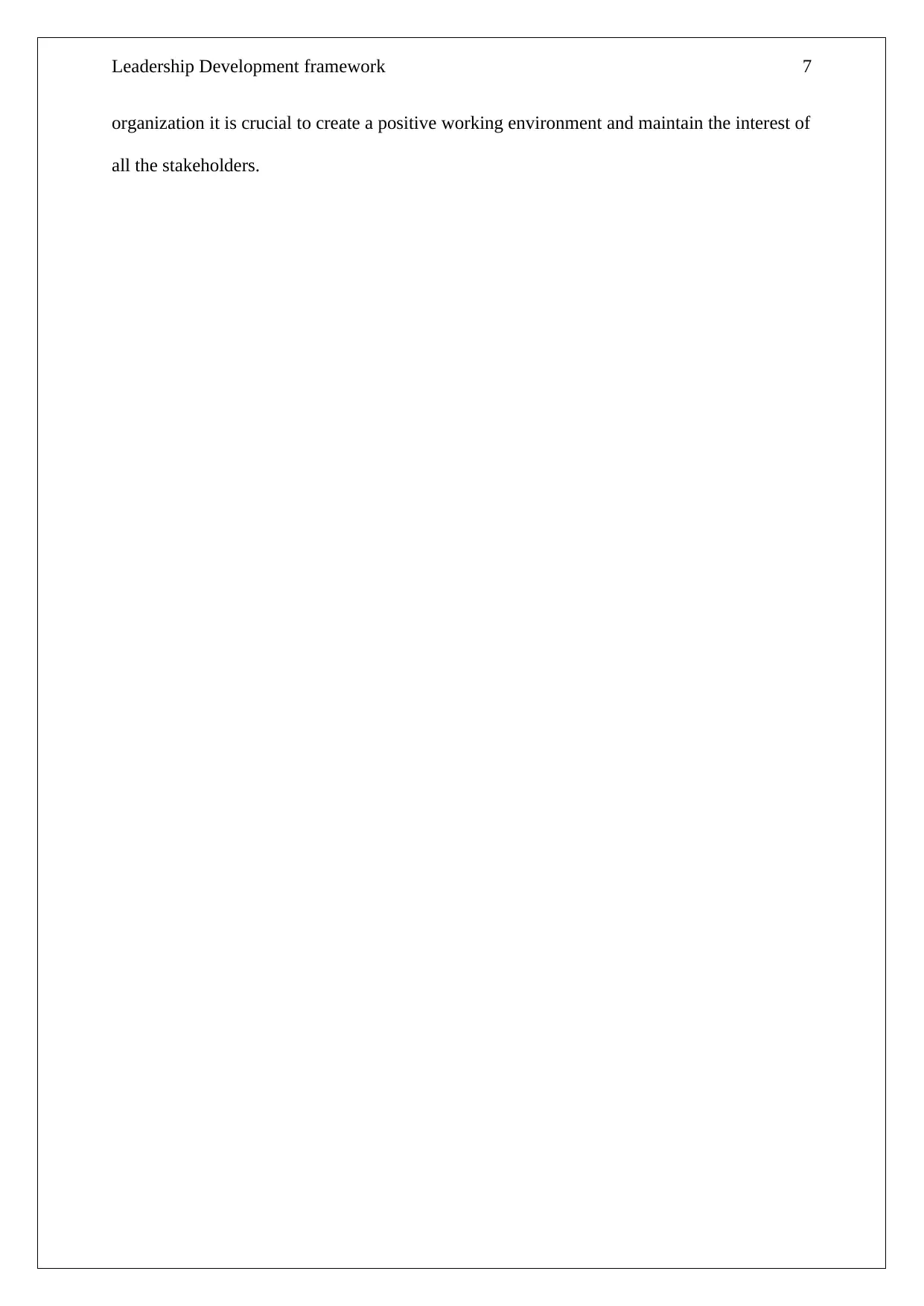
Leadership Development framework 7
organization it is crucial to create a positive working environment and maintain the interest of
all the stakeholders.
organization it is crucial to create a positive working environment and maintain the interest of
all the stakeholders.
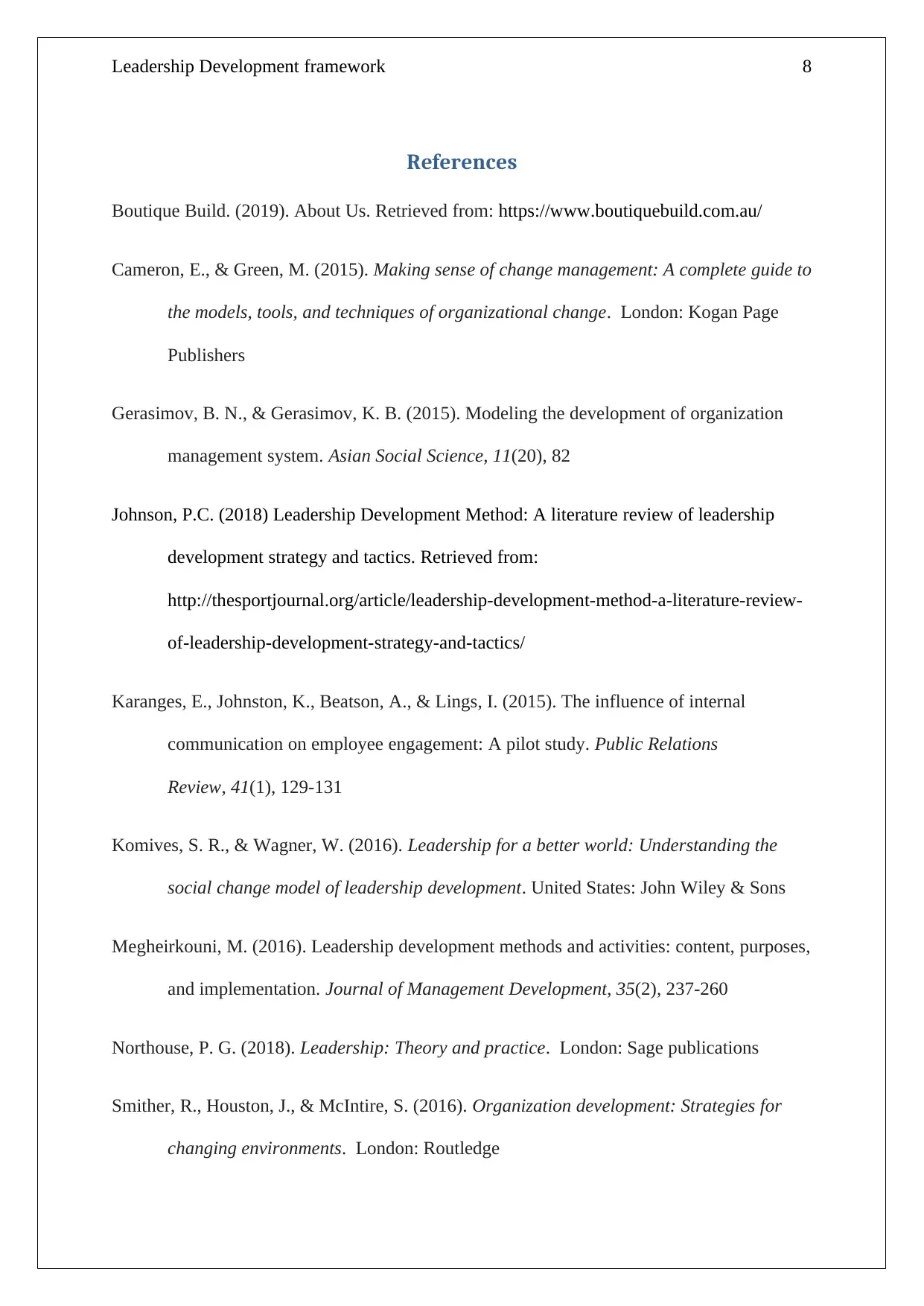
Leadership Development framework 8
References
Boutique Build. (2019). About Us. Retrieved from: https://www.boutiquebuild.com.au/
Cameron, E., & Green, M. (2015). Making sense of change management: A complete guide to
the models, tools, and techniques of organizational change. London: Kogan Page
Publishers
Gerasimov, B. N., & Gerasimov, K. B. (2015). Modeling the development of organization
management system. Asian Social Science, 11(20), 82
Johnson, P.C. (2018) Leadership Development Method: A literature review of leadership
development strategy and tactics. Retrieved from:
http://thesportjournal.org/article/leadership-development-method-a-literature-review-
of-leadership-development-strategy-and-tactics/
Karanges, E., Johnston, K., Beatson, A., & Lings, I. (2015). The influence of internal
communication on employee engagement: A pilot study. Public Relations
Review, 41(1), 129-131
Komives, S. R., & Wagner, W. (2016). Leadership for a better world: Understanding the
social change model of leadership development. United States: John Wiley & Sons
Megheirkouni, M. (2016). Leadership development methods and activities: content, purposes,
and implementation. Journal of Management Development, 35(2), 237-260
Northouse, P. G. (2018). Leadership: Theory and practice. London: Sage publications
Smither, R., Houston, J., & McIntire, S. (2016). Organization development: Strategies for
changing environments. London: Routledge
References
Boutique Build. (2019). About Us. Retrieved from: https://www.boutiquebuild.com.au/
Cameron, E., & Green, M. (2015). Making sense of change management: A complete guide to
the models, tools, and techniques of organizational change. London: Kogan Page
Publishers
Gerasimov, B. N., & Gerasimov, K. B. (2015). Modeling the development of organization
management system. Asian Social Science, 11(20), 82
Johnson, P.C. (2018) Leadership Development Method: A literature review of leadership
development strategy and tactics. Retrieved from:
http://thesportjournal.org/article/leadership-development-method-a-literature-review-
of-leadership-development-strategy-and-tactics/
Karanges, E., Johnston, K., Beatson, A., & Lings, I. (2015). The influence of internal
communication on employee engagement: A pilot study. Public Relations
Review, 41(1), 129-131
Komives, S. R., & Wagner, W. (2016). Leadership for a better world: Understanding the
social change model of leadership development. United States: John Wiley & Sons
Megheirkouni, M. (2016). Leadership development methods and activities: content, purposes,
and implementation. Journal of Management Development, 35(2), 237-260
Northouse, P. G. (2018). Leadership: Theory and practice. London: Sage publications
Smither, R., Houston, J., & McIntire, S. (2016). Organization development: Strategies for
changing environments. London: Routledge
⊘ This is a preview!⊘
Do you want full access?
Subscribe today to unlock all pages.

Trusted by 1+ million students worldwide
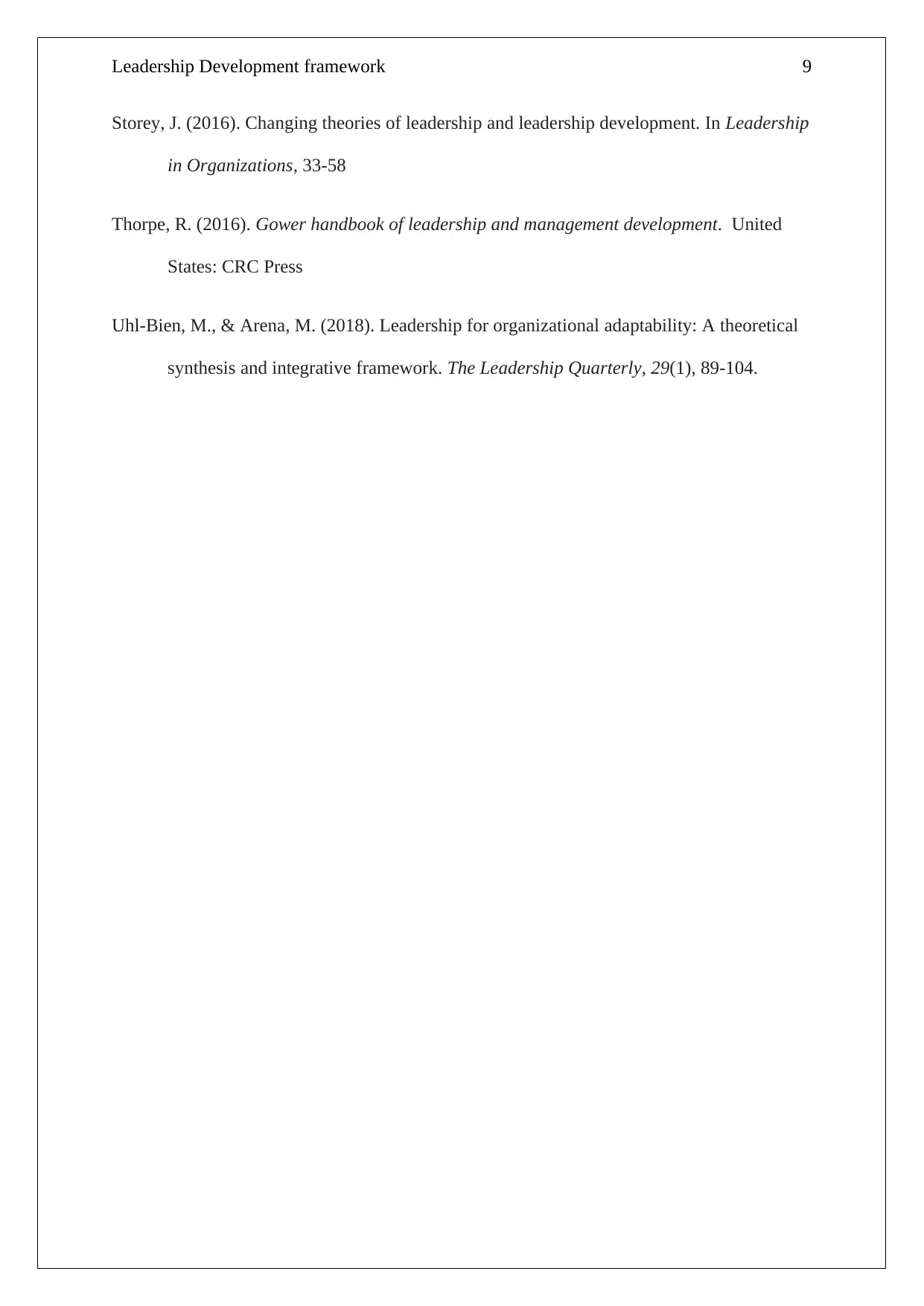
Leadership Development framework 9
Storey, J. (2016). Changing theories of leadership and leadership development. In Leadership
in Organizations, 33-58
Thorpe, R. (2016). Gower handbook of leadership and management development. United
States: CRC Press
Uhl-Bien, M., & Arena, M. (2018). Leadership for organizational adaptability: A theoretical
synthesis and integrative framework. The Leadership Quarterly, 29(1), 89-104.
Storey, J. (2016). Changing theories of leadership and leadership development. In Leadership
in Organizations, 33-58
Thorpe, R. (2016). Gower handbook of leadership and management development. United
States: CRC Press
Uhl-Bien, M., & Arena, M. (2018). Leadership for organizational adaptability: A theoretical
synthesis and integrative framework. The Leadership Quarterly, 29(1), 89-104.
1 out of 10
Related Documents
Your All-in-One AI-Powered Toolkit for Academic Success.
+13062052269
info@desklib.com
Available 24*7 on WhatsApp / Email
![[object Object]](/_next/static/media/star-bottom.7253800d.svg)
Unlock your academic potential
Copyright © 2020–2025 A2Z Services. All Rights Reserved. Developed and managed by ZUCOL.

